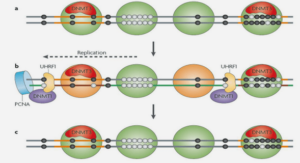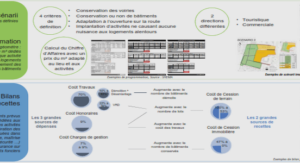Preparation of Antibody against NDH-H
The tobacco ndhH gene that extends from nucleotide 123,672 to 124,910 (Shinozaki et al., 1986; GenBank accession no. Z00044) was PCR-amplified using Pfu polymerase (Stratagene, La Jolla, CA) and cloned by blunt-end ligation into the SmaI site of pGEX4-T3 (Pharmacia Biotech, Uppsala). The recombinant plasmid was transformed into the Escherichia coli strain DH5a (Gibco-BRL, Cergy Pontoise, France). The resulting clones were sequenced to ensure in-frame fusion of ndhH with the glutathione-S-transferase gene and to avoid clones that contained PCR-generated mutations. Overexpression of the GST2NDH-H fusion protein was induced with 50 mm isopropylthio-bgalactoside for 5 h at 37°C. Bacterial cultures were pelleted by centrifugation (2,000g, 10 min) and resuspended in a buffer containing 50 mm Tris-HCl (pH 8.0), 1 mm Na2- EDTA, and 100 mm NaCl. Fusion protein was extracted from inclusion bodies by standard procedure (Sambrook et al., 1989) and separated by SDS-PAGE. The relevant band was excised from the gel and the protein was electroeluted. Antiserum was raised against the fusion protein in rabbit (Bioenvirotech, Marseille, France). Targeted Inactivation of the Plastid ndhB Gene Plant Physiol. Vol. 123, 2000 1345
Preparation of Thylakoid Membranes
Intact chloroplasts were isolated and purified from leaves using discontinuous Percoll (Pharmacia Biotech) gradients as described (Rumeau et al., 1996). Chloroplasts were osmotically lysed in MNM solution containing 20 mm MES (2-[N-morpholino]-ethanesulfonic acid), pH 6.0, 15 mm NaCl, and 5 mm MgCl2, and centrifuged for 20 min at 35,000g. The supernatant fraction comprised stromal soluble proteins. Stromal and grana lamellae were separated following a stacking step carried out as described by Sazanov et al. (1998b). Briefly, thylakoid membranes were allowed to stack for 1 h and then solubilized by adding n-dodecyl-b-d-maltoside dropwise to 1% (w/v) with constant stirring. After incubation (30 min) insoluble material was removed by centrifugation at 1,000g for 2 min, and the different fractions were recovered by differential centrifugation. Grana thylakoids were recovered by centrifugation at 10,000g for 30 min and stroma thylakoids by centrifugation at 150,000g for 1 h.
PAGE and Immunodetection
Denaturing SDS-PAGE was performed as described by Laemmli (1970) using 13% (w/v) acrylamide gels. Proteins were either stained with Coomassie Brilliant Blue or electrotransferred onto 0.45-mm nitrocellulose membranes (Schleicher & Schuell, Keene, NH) and probed with NDH-H antibodies. Immunocomplexes were detected using alkaline phosphatase-conjugated antibodies. O2 Evolution Measurements in Plants Cultured in Vitro Seedling-derived plants were grown in vitro as described (Peter et al., 1999). The leaf discs were collected from plantlets grown under 60 mmol m22 s21 photon flux density (PFD), illuminated by cool-white fluorescence tubes. The effect of light stress was analyzed by exposing the culture vessels to a PFD of approximately 700 mmol m22 s21 . The light was provided by low-voltage (12-V/50-W) multimirror halogen lamps (Precise, General Electric, Fairfield, CT). Three heat filters (Tempax, Schott, Cologne, Germany) and a water filter (10-cm height, 13°C) were placed between the culture vessel and the light source to minimize any temperature increase in the vessel. Light dependence curves of net oxygen evolution were measured at 25°C, approximately 2% (v/v) CO2 (carbonate/bicarbonate buffer), with a leaf disc oxygen electrode (LD2, Hansatech, King’s Lynn, UK) and a pulse-amplitude-modulation fluorometer (PAM, Walz, Effeltrich, Germany). The leaf discs were exposed to alternating light periods (7.5 min) and dark periods (5 min), and the PFD was raised at each light period up to 400 mmol m22 s22 . Gross photosynthesis was calculated from the difference of O2 evolution rate in the light and in the consecutive dark period.
Leaf Conductance Measurements in Soil-Grown Plants
CO2 and H2O exchange of attached leaves of soil-grown plants under humidity transition was measured in an airtight chamber. Relative humidity (75% and 30%) was set by generating moist air using a portable dew point generator (LI-610, LI-COR, Lincoln, NE) at a flow rate of 2 mL s21 . The moist air was drawn into a leaf clip (PLC model, Ppsystem, Hotchin, UK), equipped with leaf ventillation, thermistor air temperature measurement, and infrared sensor leaf temperature measurement. A gas mixer (SEMY Engineering, Montpellier, France) was used to generate gas mixture with a defined CO2 and O2 concentration. CO2 and O2 concentrations were measured using an infrared gas analyzer (LI-6262, LI-COR, Lincoln, NE) and an oxygen analyzer (OXOR 6N, Maihak, Hamburg, Germany). CO2 and H2O exchange was measured by monitoring air humidity and CO2 concentration changes in air between the inlet and outlet of the chamber. Standard calculations were used to determine stomatal conductance (Farquhar and Sharkey, 1982).
Whole-Plant Photosynthesis and Growth Measurements
Three-week-old in vitro-grown seedlings were potted into soil and grown for an additional 2 weeks in a phytotron or a growth chamber before using a stress condition. The standard conditions in the phytotron were 16-h light (250–350 mmol m22 s21 PFD, Osram HQI-T/DV lamps, 30°C–32°C), 8-h dark (22°C), 50% to 60% relative humidity. The plants were supplied six times a day by nutrient solution (one-halfdiluted Hoagland salts; Hoagland and Arnon, 1950) in an excess amount resulting in over-dipping from the soil. ABA treatment was performed by spraying 15 to 25 mL of ABA solution (10 mm) on the lower surface of all leaves of a plant every 2nd d. The computer-controlled C23A system (Fabreguettes et al., 1994) consists of air-tight twin growth chambers suitable for comparative investigation of two sets of plants. The continuously adjusted and recorded parameters in the chambers (the standard values are indicated in brackets) were the following: CO2 concentration (0.034%), O2 concentration (16%), air humidity (60 relative %), evapotranspiration, temperature (day/night: 30°C/25°C). Illumination (16-h day) was provided by metal halogen lamps (Powerstar HQI-T/D, Osram, Munich), offering 250 and 350 mmol m22 s21 PFD at the level of upper leaves of young and mature (non-flowering) plants, respectively. Water was supplied normally four times a day as nutrient solution (onehalf-diluted Hoagland salts; Hoagland and Arnon, 1950) in controlled amounts 20% to 50% more than the daily water loss by evapotranspiration. In the case of extended water stress by limited watering, after some days pure water was used to avoid salt accumulation. Humidity stress was achieved by specifying 30% and 40% relative humidity during day and night, respectively. The measurements of net photosynthesis and dark respiration were based on the quantitative balance of CO2 injection and trapping, respectively, maintaining a constant CO2 concentration (measured by an infrared gas analyzer) in the chambers (Fabreguettes et al., 1994). Air humidity was measured using, in addition to the in-built humidity detector, a portable humidity detector (Hydrodig 2010, Tecnic Instruments, Marseilles, France) at the level of leaves. Evapotranspiration was measured by Horva´th et al. 1346 Plant Physiol. Vol. 123, 2000 weighing the collected condensed water vapor. Six plants normally were grown in each chamber. The use of large growth chambers for whole-plant photosynthesis measurements does not easily allow statistical evaluation of individual plants, therefore the experiments were repeated to test their reproducibility. ACKNOWLEDGMENT






